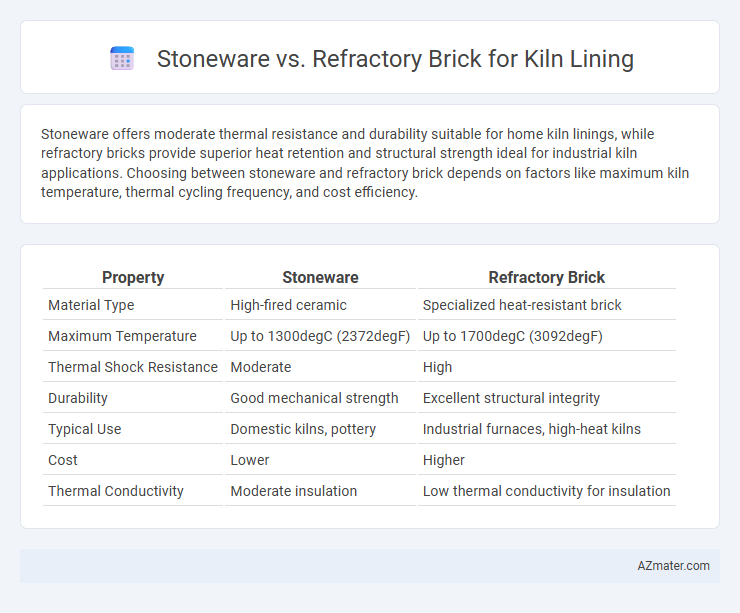Stoneware offers moderate thermal resistance and durability suitable for home kiln linings, while refractory bricks provide superior heat retention and structural strength ideal for industrial kiln applications. Choosing between stoneware and refractory brick depends on factors like maximum kiln temperature, thermal cycling frequency, and cost efficiency.
Table of Comparison
| Property | Stoneware | Refractory Brick |
|---|---|---|
| Material Type | High-fired ceramic | Specialized heat-resistant brick |
| Maximum Temperature | Up to 1300degC (2372degF) | Up to 1700degC (3092degF) |
| Thermal Shock Resistance | Moderate | High |
| Durability | Good mechanical strength | Excellent structural integrity |
| Typical Use | Domestic kilns, pottery | Industrial furnaces, high-heat kilns |
| Cost | Lower | Higher |
| Thermal Conductivity | Moderate insulation | Low thermal conductivity for insulation |
Introduction to Kiln Lining Materials
Kiln lining materials such as stoneware and refractory brick are essential for insulating and protecting kilns from extreme heat. Stoneware offers high durability and thermal shock resistance, making it suitable for repeated firing cycles, while refractory bricks provide superior heat retention and structural strength at temperatures exceeding 1500degC. Selecting the right kiln lining depends on factors including the kiln's operating temperature, firing atmosphere, and desired thermal efficiency.
What is Stoneware?
Stoneware is a dense, durable ceramic material fired at high temperatures between 1,200degC and 1,300degC, making it ideal for kiln lining due to its excellent heat resistance and mechanical strength. It features a fine-grained texture with minimal porosity, allowing it to withstand thermal shock and chemical corrosion better than standard clays. Unlike refractory bricks, stoneware offers a cost-effective solution with versatile applications in both craft kilns and industrial furnaces.
What are Refractory Bricks?
Refractory bricks are high-temperature resistant materials specifically designed to withstand extreme heat and thermal cycling in kiln linings. Made from fireclay, alumina, silica, or other ceramic fibers, these bricks provide superior insulation and structural integrity under intense thermal stress. Their dense composition and low thermal conductivity make them ideal for protecting kiln structures while maintaining energy efficiency during firing processes.
Thermal Properties Comparison
Stoneware offers moderate thermal conductivity and good heat retention, making it suitable for consistent kiln temperatures in lower-temperature firings. Refractory bricks, especially high-duty types, exhibit superior thermal insulation and higher thermal resistance, allowing them to withstand extreme temperatures above 1600degC without deformation. The thermal mass of refractory bricks enables better energy efficiency and faster recovery times in industrial kiln applications compared to stoneware lining.
Durability and Longevity
Stoneware offers exceptional durability due to its dense, vitrified composition, making it highly resistant to thermal shock and wear in kiln lining applications. Refractory bricks, composed of alumina, silica, and other minerals, provide superior longevity by withstanding extreme temperatures and chemical corrosion over extended periods. Both materials excel in heat retention, but refractory bricks typically outperform stoneware in high-temperature resilience, ensuring prolonged kiln structural integrity.
Cost Analysis: Stoneware vs Refractory Brick
Stoneware for kiln lining generally presents a lower initial cost than refractory brick due to its mass production and availability, making it a budget-friendly option for small to medium-scale kilns. Refractory bricks, although more expensive upfront, offer superior durability and thermal resistance, potentially reducing long-term replacement and maintenance costs. Balancing initial investment versus longevity, refractory bricks may provide better cost efficiency in high-temperature, industrial kiln operations.
Installation and Maintenance
Stoneware kiln linings offer easier installation due to their lighter weight and uniform shape, reducing labor time and costs compared to refractory bricks. Maintenance for stoneware involves less frequent repairs because of its high durability and resistance to thermal shock. Refractory bricks, while more traditional and capable of withstanding higher temperatures, require careful, precise installation and periodic replacement of cracked or spalled bricks to maintain kiln efficiency.
Suitability for Different Kiln Types
Stoneware offers excellent thermal shock resistance, making it ideal for pottery kilns and smaller electric kilns where rapid temperature changes occur. Refractory bricks, especially high-alumina or fireclay variants, provide superior durability and insulation in larger commercial or industrial kilns such as tunnel or roller hearth kilns. Selecting between stoneware and refractory brick depends on kiln size, firing temperature range, and the specific thermal cycling demands of the kiln application.
Safety and Environmental Considerations
Stoneware offers enhanced chemical stability and lower thermal conductivity, reducing the risk of thermal shock and improving user safety during kiln operation. Refractory bricks provide superior resistance to high temperatures and mechanical stress but may release small amounts of potentially harmful dust if damaged, posing environmental and health concerns. Selecting stoneware kiln linings ensures a safer, environmentally friendly option with minimal particulate emissions and reduced energy consumption due to better insulation.
Final Recommendations and Best Uses
Stoneware offers excellent thermal shock resistance and durability, making it ideal for high-temperature kiln linings subjected to rapid heating and cooling cycles. Refractory bricks provide superior insulation and structural stability, best suited for maintaining consistent internal temperatures in long-duration firings. For optimal kiln performance, use stoneware for smaller, portable kilns or areas requiring thermal resilience, while refractory bricks are recommended for larger, stationary kilns demanding robust insulation and longevity.

Infographic: Stoneware vs Refractory Brick for Kiln Lining
 azmater.com
azmater.com